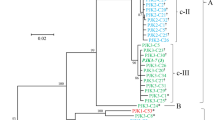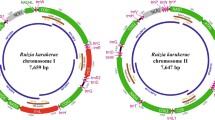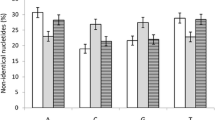Abstract
Two paralogous mitochondrial malate dehydrogenase 2 (Mdh2) genes of Xenopus laevis have been cloned and sequenced, revealing 95% identity. Fluorescence in-situ hybridization (FISH) combined with tyramide amplification discriminates both genes; Mdh2a was localized into chromosome q3 and Mdh2b into chromosome q8. One kb cDNA probes detect both genes with 85% accuracy. The remaining signals were on the paralogous counterpart. Introns interrupt coding sequences at the same nucleotide as defined for mouse. Restriction polymorphism has been detected in the first intron of Mdh2a, while the individual variability in intron 6 of Mdh2b gene is represented by an insertion of incomplete retrotransposon L1Xl. Rates of nucleotide substitutions indicate that both genes are under similar evolutionary constraints. X. laevis Mdh2 genes can be used as markers for physical mapping and linkage analysis.
Similar content being viewed by others
Reference
Bisbee CA, Baker MA, Wilson AC, Haji-Azimi I, Fischberg M (1977) Albumin phylogeny for clawed frogs (Xenopus). Science 25: 785–787.
Castresana J (2002) Estimation of genetic distances from human and mouse introns. Genome Biol 3: 1–7.
Courtet M, Flajnik M, Du Pasquier L (2001) Major histocompatibility complex and immunoglobulin loci visualized by in-situ hybridization on Xenopus chromosomes. Dev Comp Immunol 25: 149–157.
Crollius HR, Jaillon O, Dasilva C et al. (2000) Characterization and repeat analysis of the compact genome of the freshwater pufferfish Tetraodon nigroviridis. Genome Res 10: 939–949.
Emanuelsson O, Nielsen H, Brunak S, von Heijne G (2000) Predicting subcellular localization of proteins based on their N-terminal amino acid sequence. J Mol Biol 21: 1005–1016. <http://www.cbs.dtu.dk/services/TargetP/>.
Evans BJ, Kelley DB, Tinsley RC, Melnick DJ, Cannatella DC (2004) A mitochondrial DNA phylogeny of African clawed frogs: phylogeography and implications for polyploid evolution. Mol Phylogenet Evol 33: 197–213.
Force A, Lynch M, Pickett FB, Amores A, Yan YL, Postlethwait J (1999) Preservation of duplicate genes by complementary, degenerative mutations. Genetics 151: 1531–1545.
Fujiwara A, Abe S, Yamaha E, Yamazaki F, Yoshida MC (1997) Uniparental chromosome elimination in the early embryogenesis of the inviable salmonid hybrids between masu salmon female and rainbow trout male. Chromosoma 106: 44–52.
Goward CR, Nicholls DJ (1994) Malate dehydrogenase: a model for structure, evolution, and catalysis. Protein Sci 3: 1883–1888.
Graf JD, Kobel HR (1991) Genetics of Xenopus laevis. Meth Cell Biol 36: 19–34.
Hikosaka A, Kawahara A (2004) Lineage-specific tandem repeats riding on a transposable element of MITE in Xenopus evolution: a new mechanism for creating simple sequence repeats. J Mol Evol 59: 738–46.
Hughes MK, Hughes AL (1993) Evolution of duplicate genes in a tetraploid animal, Xenopus laevis. Mol Biol Evol 10: 1360–1369.
Kingston RE, Gilman M (1994–1997) Single-step RNA isolation from cultured cells or tissues. In: Ausubel FM, Brent R, Kingston RF et al. Eds. Current Protocols in Molecular Biology. USA: John Wiley & Sons, Inc., p. 4.2.1.
Krylov V, Macha J, Tlapakova T, Takac M, Jonak J (2003) The c-SRC1 gene visualized by in-situ hybridization on Xenopus laevis chromosomes. Cytogenet Genome Res 103: 169–172.
Kubota S, Kuro-o M, Mizuno S, Kohno S (1993) Germ line-restricted, highly repeated DNA sequences and their chromosomal localization in a Japanese hagfish (Eptatretus okinoseanus). Chromosoma 102: 163–173.
Kumar S, Tamura K, Jakobsen IB, Nei M (2001) MEGA2: molecular evolutionary genetics analysis software. Bioinformatics 17: 1244–1245.
Macha J, Tlapakova T, Krylov V, Kopsky V (2003) Xstir polymorphism and absence of sex linkage in Xenopus laevis ME2 gene. Folia Biol (Praha) 49: 115–117.
Matsuda M, Matsuda C, Hamaguchi S, Sakaizumi M (1998) Identification of the sex chromosomes of the medaka, Oryzias latipes, by fluorescence in-situ hybridization. Cytogenet Cell Genet 82: 257–262.
McAlister-Henn L, Blaber M, Bradshaw RA, Nisco SJ (1987) Complete nucleotide sequence of the Escherichia coli gene encoding malate dehydrogenase. Nucleic Acids Res 25: 4993.
Muller WP (1974) The lampbrush chromosomes of Xenopus laevis (Daudin). Chromosoma 47: 283–296.
Muller WE, Bohm M, Grebenjuk VA, Skorokhod A, Muller IM, Gamulin V (2002) Conservation of the positions of metazoan introns from sponges to humans. Gene 7: 299–309.
Nanda I, Schartl M, Feichtinger W, Epplen JT, Schmid M (1992) Early stages of sex chromosome differentiation in fish as analysed by simple repetitive DNA sequences. Chromosoma 101: 301–310.
Nanda I, Volff JN, Weis S et al. (2000) Amplification of a long terminal repeat-like element on the Y chromosome of the platyfish, Xiphophorus maculatus. Chromosoma 109: 173–180.
Nei M, Gojobori T (1986) Simple methods for estimating the numbers of synonymous and nonsynonymous nucleotide substitutions. Mol Biol Evol 3: 418–426.
Odierna G, Aprea G, Capriglion T, Castellano S, Balletto E (2004) Evidence for chromosome and Pst I satellite DNA family evolutionary stasis in the Bufo viridis group (Amphibia, Anura). Chromosome Res 12: 671–681.
Owens G Jr, Wiley JE (2001) Cloning of the 18S rDNA gene, an internal transcribed spacer, and the 5′ region of the 28S rDNA gene of Cope's gray treefrog, Hyla chrysoscelis. Cytogenet Cell Genet 92: 111–115.
Phillips RB, Reed KM (2000) Localization of repetitive DNAs to zebrafish (Danio rerio) chromosomes by fluorescence in-situ hybridization (FISH). Chromosome Res 8: 27–35.
Phillips RB, Zimmerman A, Noakes MA et al. (2003) Physical and genetic mapping of the rainbow trout major histocompatibility regions: evidence for duplication of the class I region. Immunogenetics 55: 561–569.
Picariello O, Feliciello I, Bellinello R, Chinali G (2002) S1 satellite DNA as a taxonomic marker in brown frogs: molecular evidence that Rana graeca graeca and Rana graeca italica are different species. Genome 45: 63–70.
Reed KM, Phillips RB (1995) Molecular characterization and cytogenetic analysis of highly repeated DNAs of lake trout, Salvelinus namaycush. Chromosoma 104: 242–251.
Schmid M, Steinlein C (1991) Chromosome banding in Amphibia. XVI. High-resolution replication banding patterns in Xenopus laevis. Chromosoma 101: 123–132.
Setoyama C, Joh T, Tsuzuki T, Shimada K (1988) Structural organization of the mouse cytosolic malate dehydrogenase gene: comparison with that of the mouse mitochondrial malate dehydrogenase gene. J Mol Biol 5: 355–364.
Sherman PA, Fyfe JA (1990) Human immunodeficiency virus integration protein expressed in Escherichia coli possesses selective DNA cleaving activity. Proc Natl Acad Sci USA 87: 5119–5123.
Stein J, Phillips RB, Devlin RH (2001) Identification of the Y chromosome in chinook salmon (Oncorhynchus tshawytscha). Cytogenet Cell Genet 92: 108–110.
Tymowska J, Fischberg M (1973) Chromosome complements of the genus Xenopus. Chromosoma 44: 335–342.
Tymowska J, Kobel HR (1972) Karyotype analysis of Xenopus muelleri (Peters) and Xenopus laevis (Daudin), Pipidae. Cytogenetics 11: 270–278.
Wiley JE (2003) Replication banding and FISH analysis reveal the origin of the Hyla femoralis karyotype and XY/XX sex chromosomes. Cytogenet Genome Res 101: 80–83.
Author information
Authors and Affiliations
Corresponding author
Rights and permissions
About this article
Cite this article
Tlapakova, T., Krylov, V. & Macha, J. Localization, structure and polymorphism of two paralogous Xenopus laevis mitochondrial malate dehydrogenase genes. Chromosome Res 13, 699–706 (2005). https://doi.org/10.1007/s10577-005-0987-4
Received:
Accepted:
Published:
Issue Date:
DOI: https://doi.org/10.1007/s10577-005-0987-4




